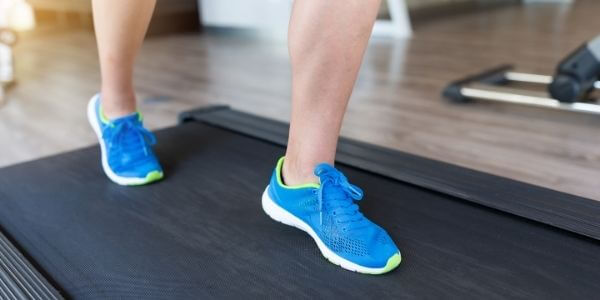Walking has been proven to improve weight loss, strengthen muscles, and prevent bone density loss. Walking also improves sleep quality, mood, and even memory.
Does incline walking have the same benefits?
The short answer is yes. You can safely do incline – even minuscule incline – walking for weight loss with terrific results. Read this article as we unpack the science behind this, sharing the secrets of how to maximize your weight and fat loss progress.
We even included a workout, so don’t miss it below:
Table of Contents
How Much Incline Walking to Lose Weight?
Studies show that even a 1% incline helps burn 12% more calories. The metabolic cost increases by:
- 17% at 5% incline
- 32% at 10% incline
Consequently, a 155-pound person expands 76 calories for each mile on flat terrain. Going uphill accelerates the calorie burn by 58.65%, adding another 44.57 calories for each mile.
Here’s the catch:
You have to maintain the same speed even when you’re going uphill.
Here’s the problem:
Treadmills have a massive temptation of choosing your own incline. If your treadmill allows a high tilt, the attraction is even bigger.
So, if you have an average or above-average fitness level, you’ll assume it’s okay to adjust your incline in the upper half.
That would be a mistake.
If you’ve never used a treadmill before, you’ll soon find that that high incline means you have to slow down your speed. That road has its own advantages; for example, it makes your leg muscles work harder, meaning you can increase your muscle mass and sculpt your legs.
But you’ll also get sore muscles and decrease calories burned.
There are two solutions to this problem:
One is increasing your incline bit by bit. If your goal is to burn more calories and accelerate your weight loss, you want to use your treadmill every other day. Setting a high incline increases the rest period.
The other solution is to choose a HIIT fat-burning program.
These programs blend incline smoothly into your routine to keep your speed constant and accelerate your fat loss. Plus, if you’re not new to this website, you know that HIIT accelerates calorie burn even after you’ve finished your workout.
Side-note: Hopefully, you have a treadmill with an array of built-in workouts to choose an incline-based routine that suits your needs. If you haven’t, YouTube is teeming with exercises you can play while on a treadmill.
Otherwise, try this 30-minute program:
- Set your timer for 60-second intervals.
- Warm-up: Three intervals at 0% incline and 3 mph
- High-intensity: One interval at 4 mph and 5% incline; one interval at 4 mph at 15% incline
- If this speed is too much for you, go back to 3 mph
- Low-intensity: Two intervals at 3 mph and 0% incline
- Repeat the high and low-intensity intervals another five times
- Cool-down: Three intervals at 0% incline and 3 mph
Does Walking on an Incline Burn Fat?

Many people practice treadmill incline for weight loss successfully. And those lost pounds aren’t just water-weight; they’re burnt fat, too.
Here’s why:
Incline Walking Boosts Your Heart Rate
Walking or running increases your heart rate, but exercising at an incline accelerates your heart faster. What’s more, that heart rate stays up even if you slow down.
According to research, each incline increase will boost your heart rate higher into the fat-burning zone.
If you want to lose weight, your goal is to reach the anaerobic or VO2 max zone. However, you should always discuss this with your doctor, especially if you have preexisting health conditions.
However, a study on 18 high-level runners showed the group’s average heart rate was 148 bpm while running for five minutes on level ground. After resting for another five minutes, the group increased the incline to a measly 2% for another five minutes.
This time, the average heart rate was 155 bpm, showing a 5% increase. Conversely, the 15% incline increase raised the group’s heart rate to 180 bpm, equivalent to an 8.22% increase.
Although this study was done on runners, not walkers, the same principle stands. So, if you want to reach the anaerobic zone, even a 2-5% incline increase will do the trick.
Related: Incline Walking vs Running
Incline Walking Builds Muscle
Walking on an incline helps you shed pounds, but it also helps you build muscle. As such, the pounds you’re shedding are fat weight.
Why does incline walking build muscle?
First, it’s science. Many studies show increased activation in the calf muscles, hamstrings, and buttocks, even with minuscule inclines of 3-6 degrees.
Secondly, you can feel it on your own.
When you’re using your legs to go uphill, you’re pushing through your calves and hamstrings while contracting your buttocks. By comparison, regular walking at zero incline makes you rely more on your quadriceps.
And that’s another reason to combine no-incline with incline walking within a HIIT workout.
We also mentioned that HIIT helps you burn fat faster. In fact, a study shows that following a HIIT routine for 12 weeks, three times per week, in 20-minute sessions produced the following effects in subjects:
- 1.5 kg weight loss
- 2 kg fat loss
- 17% reduction in visceral fat
Does Walking on an Incline Burn Belly Fat?

Yes, walking on an incline burns belly fat. The results above prove this assertion because:
- You’re losing weight
- You’re shedding fat
Some of that fat will come from your midsection, mainly because incline walking builds lean core muscles too. When you’re walking at an incline, you’ll need to engage your abs and lower back even more than during regular walking.
This extra muscle engagement ultimately translates into a better-toned mid-section.
Besides, your growing abs will torch the visceral fat deposits in the area.
There’s another reason why incline walking helps you burn belly fat:
You’re improving your heart and lung health. Some heart-related conditions can lead to fluid build-up and, therefore, weight gain.
But, if you’re building good aerobic health and endurance, you can avoid these issues.
Besides, walking improves your endocrine system, preventing hormonal imbalances. And, if you don’t already know this, hormone issues can cause unexplained weight gain, especially abdominal fat gain.
It’s called “hormonal belly,” and simply walking at a 2-5% incline can get rid of that.
Incline Walking Weight Loss Results
Understandably, you want to see quick progress. Who doesn’t? However, you have to keep up your workout routine.
As you can see, all the studies we cited above extend for at least 12 weeks, although some notice improvements in participants’ conditions as soon as six weeks.
If you want to have better (and faster) before and after results:
- Adjust your diet accordingly. You can reduce your caloric intake to 2000-2500 calories/day. If you’re already in this ballpark, some studies have shown that intermittent fasting is a good weight loss tool that prevents plateaus. Besides, intermittent fasting is also shown to improve mood and sleep, but you’ll have to ask your doctor if it’s the right tool for you.
- Walk regularly. Don’t slack off. Life happens, and there’s never really a perfect time to exercise for most of us. So instead of waiting for the planets to align, get on your treadmill and find what works for you. Even 5-minute bursts six or seven times per day may not be as good as a 35-minute routine, but they’re better than nothing.
Related: How Long Does It Take to Walk 2 Miles?
- Do HIIT. HIIT has been proven to accelerate weight loss even at rest and decrease your fat stores, including visceral fat. So, alternate walking and walking at an incline for best results (even if you’ll notice fewer calories burned during a 30-minute routine).
And, as always, choose the right treadmill for your needs. You need a walking treadmill that allows you to scale up your incline and speed accordingly. That means:
- A high enough speed and angle to increase your fitness level
- Small enough increments to help you progress faster. Whether you’re a beginner or not, you’ll notice that 0.1% or 0.1 mph increments are much smoother than 1% or 1 mph intervals. Besides, science shows that even the tiniest increase in incline and speed can accelerate your weight loss considerably.
Happy walking!
- 7 Exercises for Pregnant Women in the First Trimester: Safe and Effective - January 30, 2025
- Our equipment recommendations - October 30, 2024
- Here’s What Doing Cardio Every Day Does To Your Body - August 21, 2024

